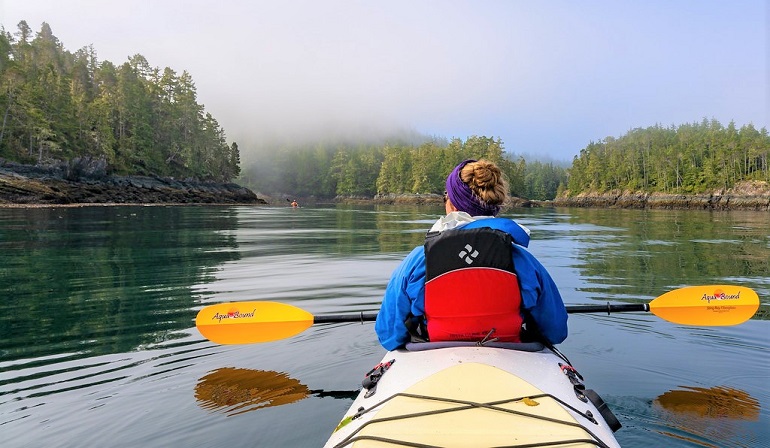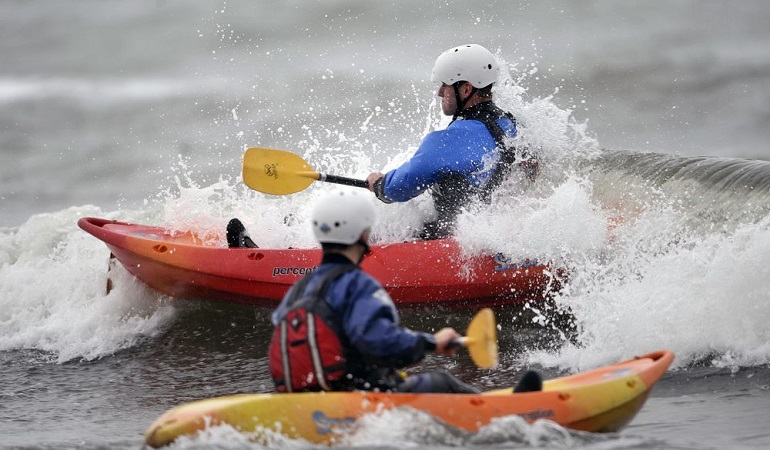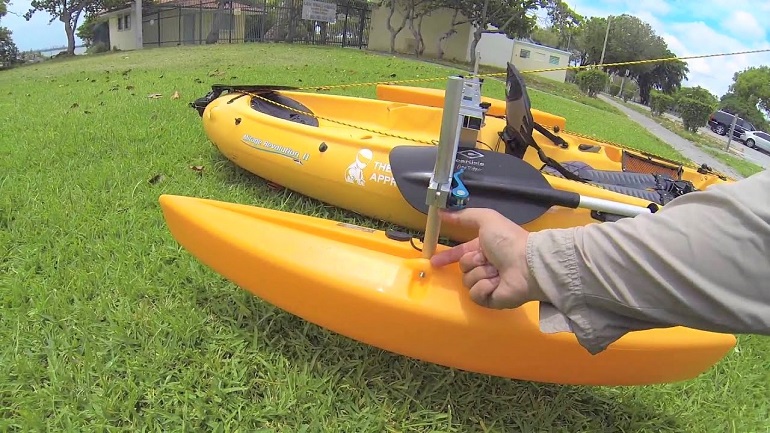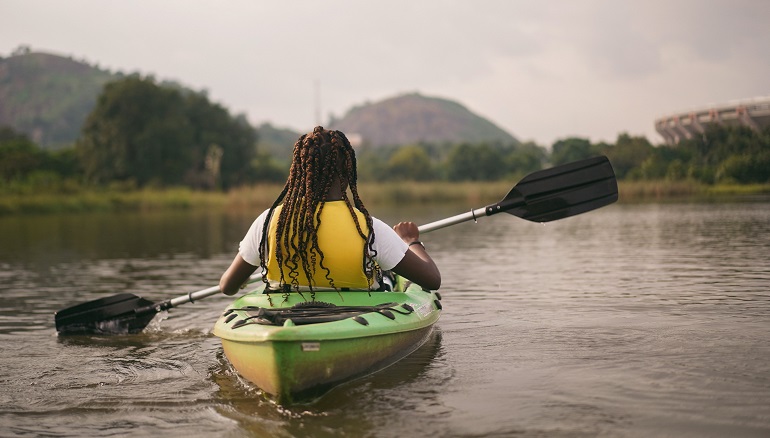Learning your balance on a kayak is a very tricky split between “There’s no way in hell I can master this” and “What am I doing wrong?”
Most of the time, it is not you! Sometimes racing kayaks need a little optimization to get them to your skill level. Not just that, maybe it is a stable kayak, but the specifications of your weight, height and kayaking strategy are just not compatible.
Hence, in such a situation, a tweak here and there is better than ditching the whole board and buying a new one. It’s also the more logical solution!
Let’s get into it.
When It Comes to Kayaking, Stability Is Key

How do you determine that your kayak is unstable? You first have to know and understand what a stable kayak feels like.
Stability in the kayak world (whether it’s an inflatable whitewater kayak or any other option) means the kayak’s capability to not give in to the possibility of capsizing.
So, that can be majorly on you and how you maneuver the kayak. But one thing is for sure…a kayak’s stability is not as affected by the water conditions as it is affected by the user’s riding technique.
First, the common belief that every kayak is ‘unstable’ on the water is a wrongly placed understanding. Just because it is a waterborne vessel doesn’t make it wobbly and unreliable all the time. In fact, kayaks are known to be more stable than canoes even.
Secondly, if you hit the waters and immediately sense a bit of a tippy kayak feel, then there definitely has to be an issue with your riding method, or this one is just not the right kayak for you.
If the kayak stability is unreliable and you can’t find your balance on top of the vessel, then there’s really no fun in the sport at all, huh? Also, sizing your kayak paddle the right way is an important factor.
That’s why the following guide will be perfect for helping you understand what’s lacking, what needs improvement, and how you can perfect your technique to get the most out of your experience.
Factors That Impact Your Kayak’s Stability

In order to understand good stability on a kayak, you must first comprehend the concepts of primary and secondary stability.
Primary stability is the first impression you get when you sit in an upright position on the kayak on top of flat water. Good primary stability means you can shift and move side to side, and the vessel won’t capsize.
However, regardless of how stable and firm the boat feels, this observation is insufficient to gauge your kayak’s stability completely.
On the other hand is secondary stability; the boat’s ability and persistence to stay upright even if one or both sides are completely immersed in the water.
This second type of kayak stability is very important in challenging waters like choppy waters and maybe a few waves.
Now, let’s see the different specifications that affect the primary and secondary stability of your kayak.
Width

One of the many specifications that play an integral role in improving stability is your kayak’s width. A longer width is generally known to give you perfect stability so that you can remain upright on it for as long as you’re riding.
Regardless of the weather and water conditions, if you have a wider kayak, there’s a higher possibility it will remain stable and strong through everything.
Although very wide kayaks are not advised for novices and beginners, as they are difficult to turn and navigate, it doesn’t hurt to cruise on calm water on them for a bit.
Hull Shape
A flat hull is greatly recommended for kayak owners who really don’t want to always to bending to their kayak.
With a flat hull, the kayak stays upright and floats beautifully with minimal effort from the rider’s side. This is the type you want to look for if you’re buying top fishing kayaks.
However, if fishing kayaks are not your goal and you’re looking more into the best touring kayak, a flat hull design should be out of the question. Look for a V-shaped kayak’s hull instead.
Weight Distribution

To balance anything in the world, you have to place the majority of the weight right in the subject’s center of gravity.
In the same way, to achieve good weight distribution and improve kayak stability, find the boat’s center of gravity and place your body weight around there. Keep that in mind when loading your gear too.
The Balancing Ability of The Kayaker
Placing too much weight on the right or left side of your kayak could lead to the boat upending.
Remember not to get too caught up in the sport and heed the advice that kayaking is a multitasking activity. You need to learn how to maneuver the kayak and, at the same time, place your body weight wisely.
Steps You Can Take to Increase the Stability of Your Kayak
If you have resolved and removed from the question the possibility that maybe your touring kayak isn’t the perfect fit for you, then let’s move to the next step of making your kayak more stable.

Adjust Your Seat to a Lower Height
With sit-inside kayaks, one can sometimes get too excited about the attachable seat. I know I did and accidentally hiked it up a bit too much. That’s when I ended up in the water with my sit-in kayak on top of me.
As we discussed before, the center of gravity is important to determine. So, of course, it’s not going to be 2 feet up in the air. By sitting lower, you ensure that the gravity center is both stronger and engaged while maintaining a good understanding and control of your paddling technique.
Fix the Weight Distribution

Sometimes too much gear on one end of the kayak can mess with the same boat that could otherwise withstand a lot of weight as long as it is well divided across the boat. However, in some cases, it’s not that your gear is too much…but, in fact, too less.
If you’re traveling light, and the kayak is feeling wobbly or unstable, then you can balance out the equation by filling a bag or two with sand and distributing them across the bow and stern.
Be Even More Attentive About Weight if You’re in a Two-Seater

Even an experienced kayaker can mess up with a longer tandem kayak. A kayak designed to accommodate 2 people can sometimes be hard to master.
It is especially tricky when one person seated is heavier or bigger than the other. For example, if you’re traveling with a kid, they’ll never match up to your weight.
In such scenarios, you can add extra weight, as I explained in the previous paragraph, to the lighter side.
Invest in a Stabilizer

A kayak outrigger or a stabilizer is an easy temporary way to give better secondary stability to your kayak.
Kayak outriggers have long extensions fastened to a floatation device attached to either side of your kayak, giving better primary stability and helping you ride the kayak confidently. Think of this outrigger kit as training wheels to make your kayak more stable.
Think About Using a Different Kayak
When you have exhausted all your options, and it feels like you have even tried out all the whitewater kayaks out there but still have no idea how to make a kayak more stable…maybe it’s a sign to jump ship. Literally!
If a whitewater kayak is not suiting your requirements and you’re looking for more stability to explore a new form of the spot, like maybe kayak fishing, you should start seriously thinking about finding yourself a new vessel.
But this time, do your research, and even try giving the boat a test run before making the final purchase.
Consider Short, Sit-on-Top Kayaks

Beginners are advised to go for a simple, basic, short flat bottom kayak with a sit-on-top system for a start. These don’t risk any kayak instability and also give you the extra boost of confidence and energy to actually immerse yourself in the sport.
After getting the hang of it, you can transition to more advanced models.
Conclusion
There are mainly 2 reasons why your kayak is unstable, unreliable, and uncooperative. It could be either poor technique, or the kayak is simply not the one for you and your body or paddling skills.
Regardless of how the issue came around to be, there’s always a solution, as no kayak designed is meant to wobble you about in the water like a fish head in gumbo soup. You might also want to learn how to store a kayak in the right way to increase its life.
0 Comments